When you look into a room filled with red, yellow and orange decor, your brain tells you that it should be hot in there. Conversely if the room has blue walls, and violet or green decor, you sense that the room should be cool. Color temperature enables artists and decorators to create mood, perspective, emphasis, rhythm, and a sense of time and place.
A color mixture becomes warmer
as more red is added to it and a color cools as blue is added. Therefore red violet is warmer than violet and blue violet is cooler. Yellow orange is a warm yellow. Yellow green is a cool yellow. Even greens can be warm or cool, but remember red is the complement of green. As more red is added, the green will become muted and a variety of warm grays will be created.

This is Bacchante 1894 painted by William-Adolphe Bouguereau (1825-1905). Notice the variety of warm green grays created by mixing red into green. (You can also make warm blue grays by adding orange, the complement of blue.)
A predominance of cool or warm colors unifies the painting. So, a decision has to be made. Ask yourself some questions. What is the season, the time of day in my painting?
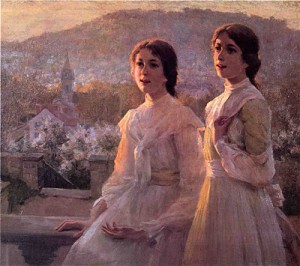
Hamilton Hamilton (1847-1928) (This really is his name.) painted Lil’l Southern Belles in 1894. He has used a cool palette with warm touches to create a time of day.
Is my composition in lamplight or sunlight?
In 1888 Paul Gauguin (1848-1903) painted a portrait of Van Gogh sitting in the sunshine. He entitled it The Painter of Sunflowers-Vincent Van Gogh. The warm colors, high value, and shadows emulate the light outside.
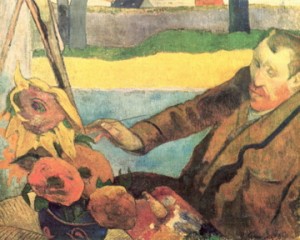
Is it filtered through a colored curtain or a canopy of green leaves or dark clouds?
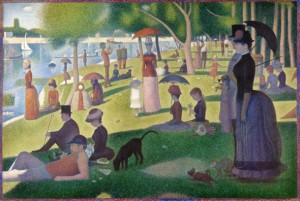
Photo from www.public-domain-photos.org/georges-seurat-a-sunday-afternoon-on-the-island-of-la-grande-jatte (If this site gives you a 404, just type the name in the search button.)
Georges Seurat (1859-1891) painted A Sunday Afternoon on the Island of La Grande Jatte in 1884-86. He is considered a Neo-Classicist. He used the pointillist technique (painting with dots of several colors for the eye to blend). Note the reds in the foreground, the yellow greens in the sun and the cooler palette in the receding distance. The colors create receding planes. Perspective or depth of space can be created because cool colors recede and warm colors come forward, especially red.
Depth and movement is achieved in abstract paintings with warm and cool colors playing against each other.
Is the light reflected off of water or a colored wall or tablecloth or a sunset colored sky?
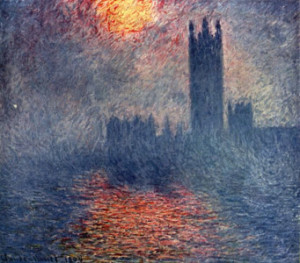
Photo from www.worldhistoryforusall.sdsu.edu/eras/era8.php
Claude Monet (1840-1926) paints the heavy wet fog filtering the sun in Houses of Parliament, London, Sun Breaking Through Fog, 1904. The painting is predominantly cool, making the warm sun and reflection painted in complementary hot colors extraordinary in contrast.
What is the mood? Joyous, sombre, playful, elegant, mysterious, inviting? 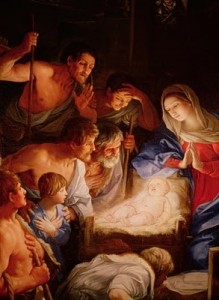
This is a warm. joyous painting using the chiaroscuro technique. It is entitled Jesus: Adoration of the Shepherds by Guido Reni (1575-1642), an Italian painter of high-Baroque style.
If the painting is cool, a warm color can bring emphasis.
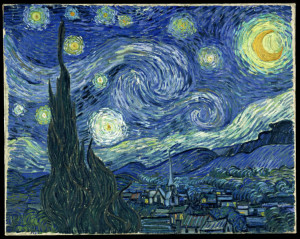
Cool blues dominate Vincent Van Gogh’s (1853-1890) Starry Night Over the Rhone 1889, but the yellow flashes make this painting sparkle and vibrate. Are the yellows cool and the moon warmer in color temperature?
Or a series of warm spots can draw the eye through a rhythmical pattern of the composition.
Photo from http://www.doverpublications.com/ .120 royalty-free paintings CD-Rom
Pierre Auguste Renoir (1885-1952) created a predominantly blue and white painting of warm shade entitled Luncheon of the Boat Party 1881. However, the contrasting yellow orange hats catch our eye and move us in a rhythmical pattern through the painting. Note how he warms the blues with red in the foreground.
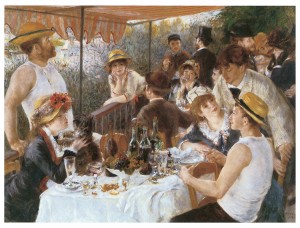
Choose your palette with an eye on the temperature of your colors. Decide which will dominate and use the opposite to create rhythm, emphasis, mood, and light effects to show perspective or time of day.
We can use the information from these posts to analyze what decisions John Constable made in his painting.
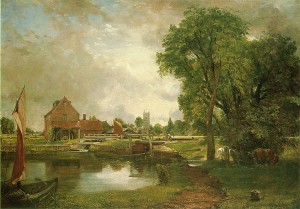
He selected a wide landscape view. The small red sail is on a point of the Golden Mean. the cathedral, tree, and sheds are within the four points of the Golden Ratio. Are the colors pure and saturated? No, some are muted with white becoming tints and some are mixed with their complement. Is the dominating value high key or low key? Did he use the techniques of chiaroscuro or tenebrism? Is the painting of high value contrast or low value contrast? Are the colors from a complementary, split complementary, analogous, or monochromatic palette?
Try this again, on other paintings.
All of these paintings are taken from public domain websites. You can find them on www.google.com/images? Type into the Search box the words “public domain” and the name of the painting. Note that some of the photos have been identified as being from another source.


